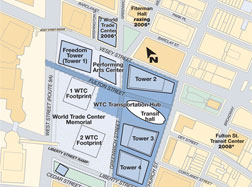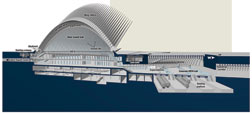...projects trail the hub in development. The interdependencies make it difficult to change any element without creating consequences almost everywhere else, says Calatrava, who is DDP’s design architect-structural engineer.
 |
| Fuzzy Fences. Hub interfaces with other WTC projects, which complicates design. |
Organization of DDP’s full-service team is almost as convoluted as the hub’s space plan. There are 180 full-time employees, including 120 from 40 subconsultants. Most work out of a job office just blocks from Ground Zero.
DDP’s contract began Aug. 3, 2003. Dominick M. Servedio, DDP’s principal, thinks the partners’ experience with FTA procedures was a factor in the selection.
Calatrava wanted a freestanding structure, which he says developed from his sketches of“a child opening her hands to release a dove into the air.” But the WTC master plan by Daniel Libeskind has the transit hall attached to a planned office tower. Calatrava also wanted to shift the hall to incorporate part of the master plan’s Wedge of Light plaza. DDP ultimately won consensus for the changes from the governor, the mayor, the PA and Libeskind. “That was our first breakthrough,” says Servedio
Avian Inspiration
As conceived, the dove’s backbone is defined by a pair of parallel piggyback arches, 50 ft apart at their midpoint. The arches spring from east and west abutments at grade and span 340 ft along the longitudinal axis of the hall, itself an elongated ellipse in plan, 340 x 113 ft.
Each piggyback arch consists of a lower fixed arch, 5 to 8 ft deep, and an upper operable arch, about 20 ft deep. The operable arches are dimensionally bigger because steel rafters, 30 to 180 ft long, cantilever from them, forming the dove’s asymmetrical wings.
 |
| WTC Transportation Hub. Expressed steel arches in transit hall span 340 ft. Expressed, undulating concrete arches in PATH hall span 170 to 260 ft. (Rendering courtesy of DDP) |
In the design, each piggyback arch is supported by 56 ribs, 5.5 ft on center, that form half a rib cage. Glazing will fill between ribs, letting daylight into the grand hall. The 1-ft-wide ribs, to be fabricated of steel plates and shapes, splay out from 4 to 12 ft at their tops. A tension ring at grade restrains dynamic lateral forces of the ribs and arches. A compression ring, also at grade, counteracts tension ring behavior.
On temperate days, and on Sept. 11, the 113-ft-long roof will open as much as 30 ft at its 120-ft zenith to show a slice of the sky. The opening will be part of ventilation and smoke exhaust systems.
A series of pistons at arch abutments will move the operable arches on rollers. As pistons pull away from the hall, the arches will bipart, opening the roof and “flapping” the wings. As pistons push back, the arches will roll toward each other, closing the roof.
Wing movement will be accommodated by three types of joints between fixed and operable arches, at the abutments. One joint will transmit only the shear in the plane of the ribs and lock the movable arches in either open or closed position. A second will transmit an additional tangential load in the plane of the ribs. A third will be able to transmit radial load, but no shear or bending moment.
To limit horizontal deformation and lateral torsional buckling of wing rafters, DDP will provide tubular elements in the transverse direction of the rafters, both within each and from rafter to rafter.
The steel structure will be designed to handle combinations of gravity, wind, seismic, ice, snow and temperature loads, as well as site-specific blast loads.
 |
| Temporary. Terminal built after Sept. 11, 2001 will be razed. (Photo by Nancy Soulliard for ENR) |
As conceived, the PATH hall ceiling, outlining a trapezoid in plan, has 14-in.-wide concrete arches of varying shapes and dimensions, and spaced 5.5 ft apart. Spans vary from 170 to 260 ft. At their ends, arches frame into a 170-ft-long triangular-in-section box beam. The beams run perpendicular to the arches but are not parallel to each other. On the west side, box beams frame into a shear wall, running north-south. On the east side, they frame into a triangular box girder, about 170 ft long. The box girder extends beyond the PATH hall, about 30 ft to the north and south, to bear on a series of supercolumns. The concrete box beams and girder may contain an embedded steel truss. Their triangulation stabilizes against torsional movement, says DDP.
Calatrava’s design calls for glass between the arches, to let light into the hall and, via openings in the floor, to train platforms. The hall’s roof would be a surface for an outdoor plaza at grade.
Construction is picking up. Phoenix expects a slew of awards by month’s end. These include subcontracts for an east perimeter slurry wall and temporary support for an existing subway tunnel.
“In 18 months’ time, this place is going to be cookin’,” says Winsper.
